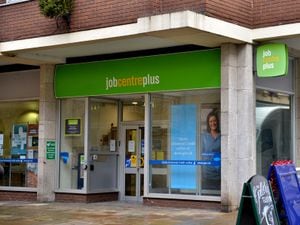Unemployment falls again in Shropshire and West Midlands
Unemployment fell again in the West Midlands – including Shropshire – in the three months to May.

The number out of work in the region was 132,000 – down 2,000 on the three months to April and a drop of 35,000 from a year earlier. The unemployment rate is 4.4 per cent of the working population.
The number in employment in the West Midlands was 2.84 million – 60.2 per cent.
Nationally the rate of unemployment fell to 3.8 per cent at 1.28m.
The numbers claiming unemployment benefits, including Universal Credit, in the West Midlands were down 3,735 to 179,935 last month – a rate of 4.9 per cent.
In Shropshire the number of claimants was down 130 to 4,560 with Telford and Wrekin down by 95 to 4,115. Powys had a drop of 90 to 1,740.
Ben Marr, partnership manager (Shropshire) for the Department for Work and Pensions, said: "Unemployment in Shropshire and Telford continues to fall at a greater rate than the wider West Midlands area.
"The latest quarterly data shows that both local authorities and all the constituencies within Telford and Shropshire had a greater reduction in people who were unemployed and looking for work than in the wider West Midlands.
"Shropshire local authority area had a reduction of 42 per cent on the year to May 22 and Telford and Wrekin a reduction of 33 per cent on the year. This compares favourably against the wider West Midlands, which again showed a healthy reduction of 30 per cent on the year.
"Youth unemployment figures are also very encouraging with Shropshire seeing a reduction of 56 per cent and Telford and Wrekin a reduction of 44 per cent, for those aged 18-24, who are unemployed and looking for work in the May 22 figures.
"DWP recently ran its very successful Way To Work Campaign to help fill the record number of job vacancies and move people into work.
"As part of this campaign, the Jobentres across Telford and Shropshire focused on weekly jobs fairs throughout June, targeting different key sectors in the area. This was an effective way to help match our jobseekers to local employers and was a significant factor locally in helping people take up some of the record number of vacancies across the region.
"Moving forward we will continue to run regular jobs fairs with local employers to help them recruit, ensuring that the process is efficient and beneficial for both parties. We regularly have employers and partners within our Jobcentres to promote current vacancies and conduct job interviews, as well as offering more support to those who need it most."
Meanwhile, Britons saw their pay packets continue to lag heavily behind inflation despite a slight rise in earnings.
The Office for National Statistics revealed that regular wages excluding bonuses plunged by 3.7 per cent over the three months to May against the rate of consumer price index inflation, representing the biggest slump in more than 20 years.
Regular pay, excluding bonuses, rose slightly to 4.3 per cent for the period, without taking inflation into account.
It comes after CPI inflation hit a 40-year record of 9.1 per cent in May and is expected to reach as high as 11 per cent later this year.
Bills have surged due to soaring energy and fuel bills amid the impact of the Ukraine war, but many have seen wages struggle to keep up.
The ONS added that total pay including bonuses lifted by 6.2 per cent for the three-month period, as workers in the financial sector drove a rise in bonuses.
Pressure on wages came as official figures showed that the number of UK workers on payrolls rose by 31,000 between May and June to 29.6 million.
Unemployment fell as job vacancies also continued to increase, with major staff shortages in industries such as hospitality.
There were 1,294,000 job vacancies over the three months to June, representing a 6,900 rise on the previous quarter.
ONS head of labour market and household statistics David Freeman said: "Today's figures continue to suggest a mixed picture for the labour market.
"The number of people in employment remains below pre-pandemic levels and, while the number of people neither working nor looking for a job is now falling, it remains well up on where it was before Covid-19 struck.
"With demand for labour clearly still very high, unemployment fell again, employment rose and there was another record low for redundancies.
"Following recent increases in inflation, pay is now clearly falling in real terms, both including and excluding bonuses."
Chancellor Nadhim Zahawi said: "I am acutely aware that rising prices are affecting how far people's hard-earned income goes, so we are providing help for households through cash grants and tax cuts.
"We're working alongside the Bank of England to bear down on inflation, providing support worth £37 billion this financial year for the cost of living, and investing in skills to help people get into work and progress."
Pat McFadden, Labour's shadow chief secretary to the Treasury and Wolverhampton South East MP, said: "Today's record fall in real wages comes after a decade where wages have stagnated for workers across the economy.
"This is because the Conservatives have failed to grow the economy, which has left people more exposed to inflation and the cost-of-living crisis.
"Labour's number one mission in government would be to grow our economy, making the country more prosperous and making its people better off."
Matthew Percival, CBI Director for People and Skills policy, said: “Persistent labour and skills shortages are hitting growth and business investment, exacerbating the cost-of-living crisis. Boosting business confidence to accelerate growth should be front of mind for the current and next Government.
“The Government should make the skills and immigration systems responsive to shortages by updating the Shortage Occupations List, the courses eligible for the Lifetime Skills Guarantee, and reforming the Apprenticeship Levy to unlock business investment in the full range of skills the economy needs.”
British Chambers of Commerce head of people policy, Jane Gratton, said: “The labour market remains incredibly tight, in many cases affecting firms’ ability to maintain normal operations. Although these figures show the employment rate has risen it is having no noticeable impact on the overall number of job vacancies.
“The problems in the labour market are restricting growth and choking off any hope of a recovery for many firms; as inflation, supply chain disruption and energy costs also add to their headaches.
“But there are several avenues open to businesses and the government to shift this data in the right direction.
“We need to bring more economically inactive people back into the UK labour market by offering flexible working practices, rapid re-training opportunities and a focus on workplace healthcare and support.
“The Government must also reform the Shortage Occupations List criteria to include more jobs at more skill levels to give firms breathing space to train and upskill their workforce.
“The huge number of vacancies is holding back productivity and growth, and employers are at their wits’ end.”





